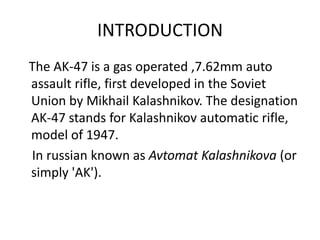The AK-47 is a gas-operated 7.62mm assault rifle developed in the Soviet Union by Mikhail Kalashnikov and adopted in 1949. Over 100 million AK-47s have been produced, making it the most widely used rifle in the world. It features a simple design, is inexpensive to produce, easy to use and maintain, and is highly reliable even in harsh conditions. The AK-47 fires the 7.62x39mm round with an effective range of 300 meters fully automatic or 400 meters semi-automatic. It remains in service with militaries and has been manufactured in many countries due to its low production cost and ease of use.
![KLASHNIKOV [AK-47]](https://image.slidesharecdn.com/klashnikovak-47-130330015107-phpapp01/85/Klashnikov-ak-47-1-320.jpg)













